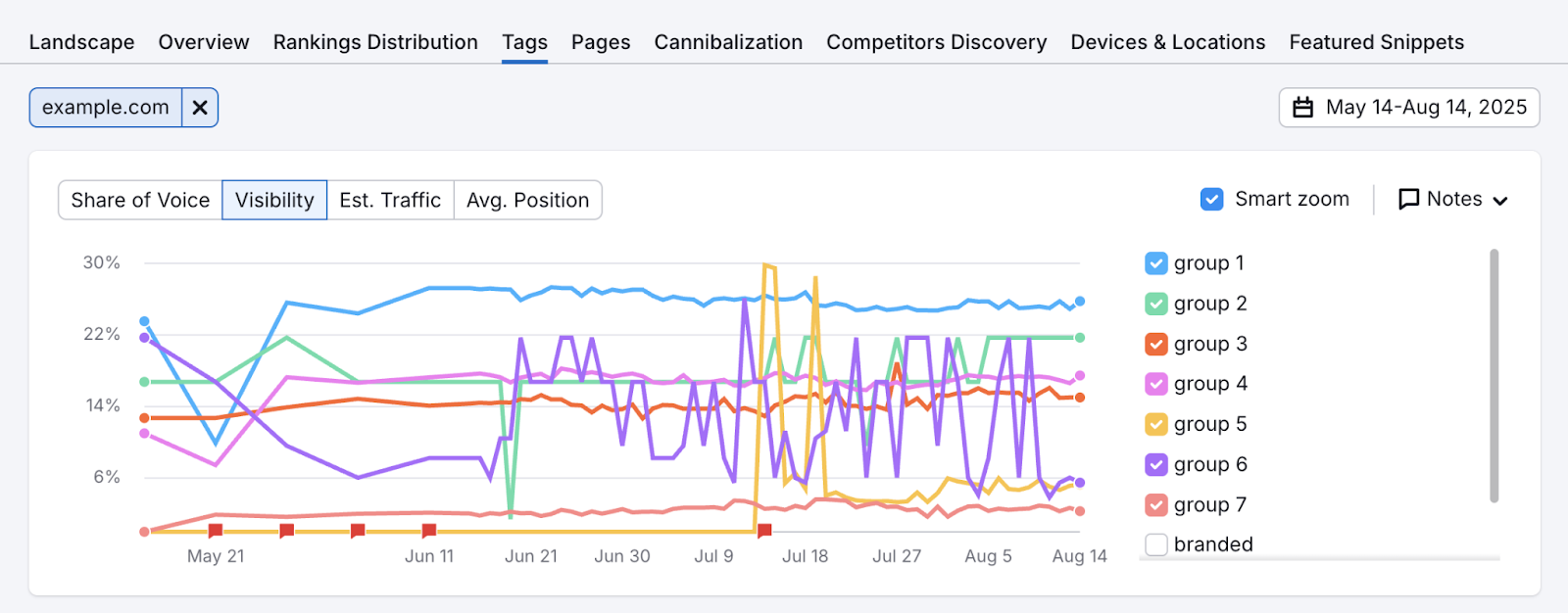What Is SEO Visibility?
SEO visibility is a metric representing how likely users are to see your website in organic (unsponsored) search engine results for one or more target keywords—usually on Google.
For example, this #1 organic result has high SEO visibility:
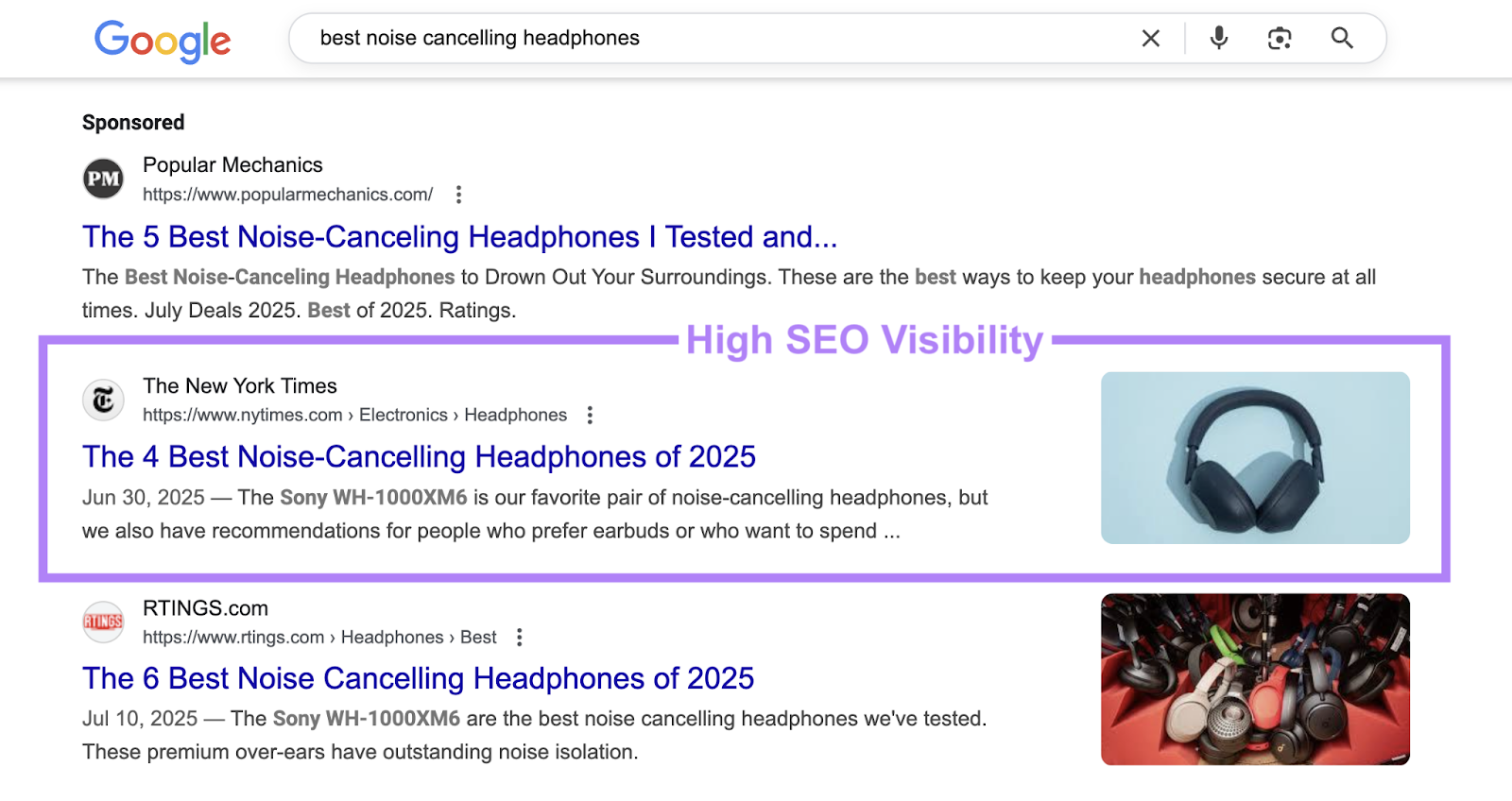
SEO rankings and SEO visibility are closely linked, but the relationship between them isn’t proportional.
Top-ranking results drive exponentially more visibility than low-ranking ones because users typically focus on the first result(s) they see and rarely scroll further.
This graph shows the general correlation between SEO visibility and organic positions:
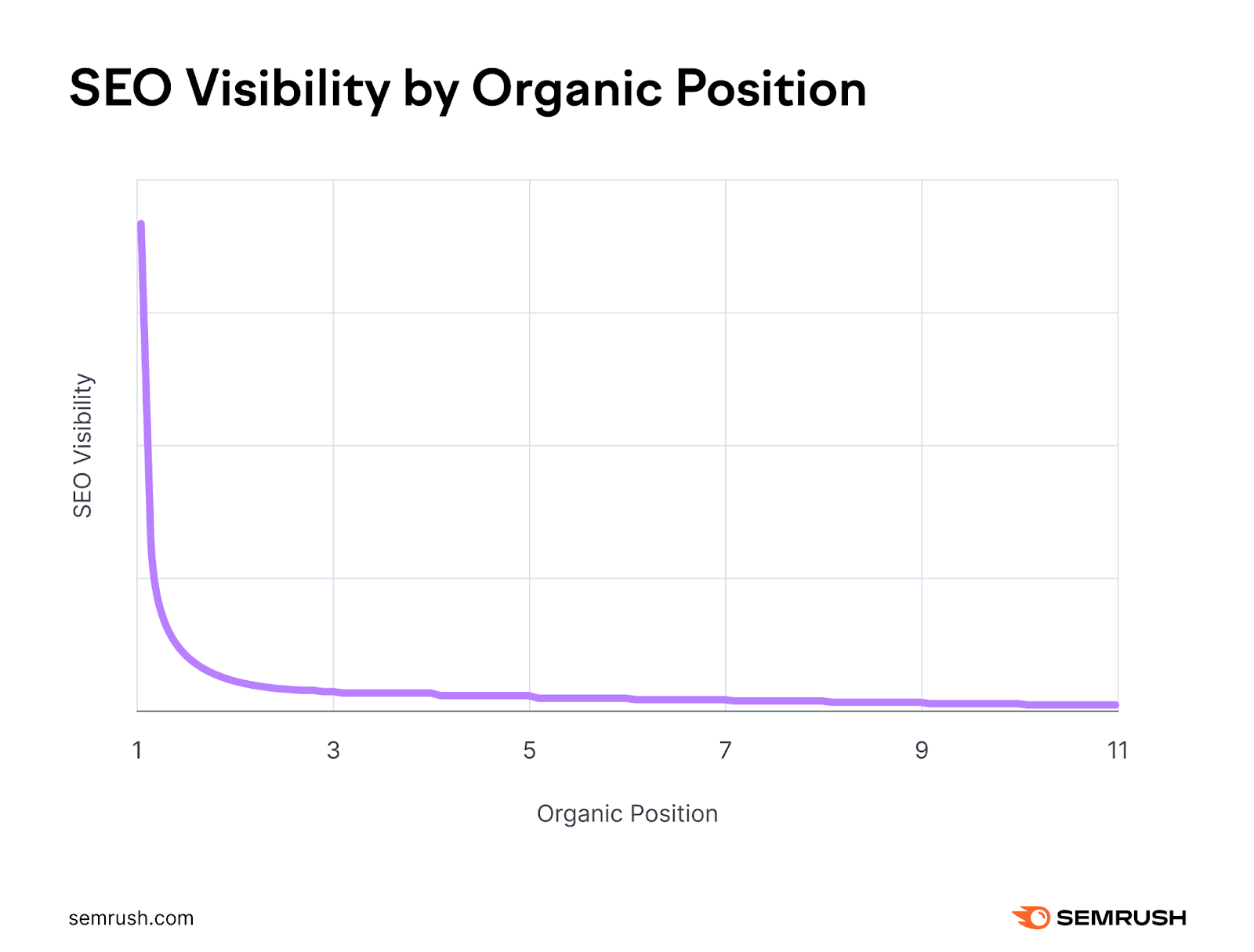
As you can see, position changes among terms you rank highly for have a drastic impact. So, moving from position 3 to position 1 dramatically increases SEO visibility.
Conversely, position changes among terms you have low rankings for will have little impact. So, moving from position 100 to position 60 likely won’t noticeably improve SEO visibility—even though that’s a significant improvement in ranking.
What Is an SEO Visibility Score?
An SEO visibility score is a percentage representing your SEO visibility, and the metric is usually calculated by a rank tracking tool.
Tools can calculate SEO visibility in different ways, considering factors such as:
- Keyword rankings: Your organic positions for target keywords, weighted according to their expected visibility on results pages
- Impression share: The portion of users who search specific keywords and see your results on their screens
- Click share: What portion of all clicks on results pages go to your website
- Click-through rates: The portion of users who click or are expected to click your search results after viewing them
- Search volumes: The average number of searches for each keyword
Visibility can be a good indicator of SEO performance. But it’s important to consider visibility alongside other SEO metrics. Because higher visibility doesn’t always drive meaningful or proportionately better results for your business.
For example, increased visibility for commercially focused or popular keywords will likely drive more revenue than increased visibility for non-commercial or unpopular keywords.
Visibility Scores in Semrush
Semrush’s visibility metric is calculated by considering all your target keyword rankings and weighting them based on their average click-through rates (according to Semrush data).
This means each ranking has a realistic impact on your visibility score. And that visibility scores are intuitive to understand and compare.
- 100% visibility represents a #1 ranking for all target keywords
- 50% visibility means you’re around half as visible as you possibly could be
- 0% visibility means you don’t rank for any target keywords
A good visibility score in SEO depends on the number and nature of keywords you’re targeting.
To give you a general idea, here are three visibility scores based on fictional rankings for websites tracking 10 keywords each:
| Keyword | Website A Rankings | Website B Rankings | Website C Rankings |
| keyword one | 1 | 2 | 10 |
| keyword two | 2 | 3 | 20 |
| keyword three | 3 | 4 | 30 |
| keyword four | 4 | 5 | 40 |
| keyword five | 5 | 6 | 50 |
| keyword six | 6 | 7 | 60 |
| keyword seven | 7 | 8 | 70 |
| keyword eight | 8 | 9 | 80 |
| keyword nine | 9 | 10 | 90 |
| keyword 10 | 10 | 11 | 100 |
| SEO Visibility | 24.45% | 14.45% | 0.6% |
You can create your own visibility benchmarks by looking at your competitors’ scores for target keywords. It’s also helpful to track how your own SEO visibility changes over time.
You can monitor your and your competitors’ visibility scores with the Position Tracking tool.
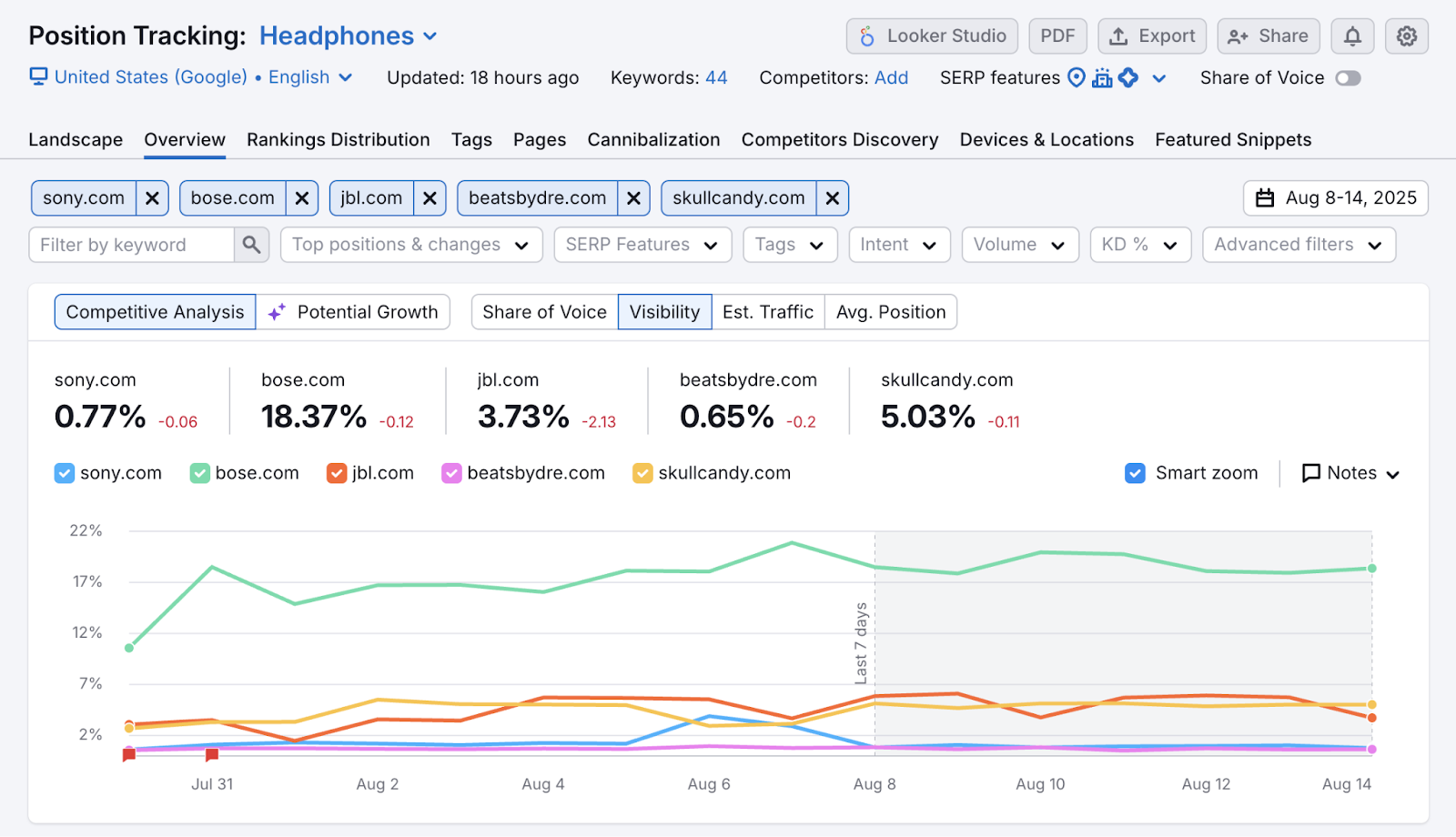
What Affects Your SEO Visibility?
Anything that affects your rankings affects your organic search visibility because higher-ranking webpages usually have higher click-through rates (CTRs).
Google ranks search results by evaluating their relevance, quality, and usability in reference to the meaning and context of the user’s query.
Other factors, such as keyword search volume and actual click-through rates, may also affect your SEO visibility score. It all depends on how you calculate the metric.
4 Best Ways to Increase Your SEO Visibility
You can increase your SEO visibility by focusing on keyword rankings in positions 2-12, targeting low-difficulty keywords, optimizing for search engine results page (SERP) features, and building your brand.
This is on top of following standard SEO best practices.
Let’s explore these SEO visibility tips in more detail:
1. Focus on Keyword Rankings in Positions 2-12
If you’re already ranking in position 2-12 for a target keyword, our data shows that a one-position ranking increase can have a relatively big impact on your SEO visibility.
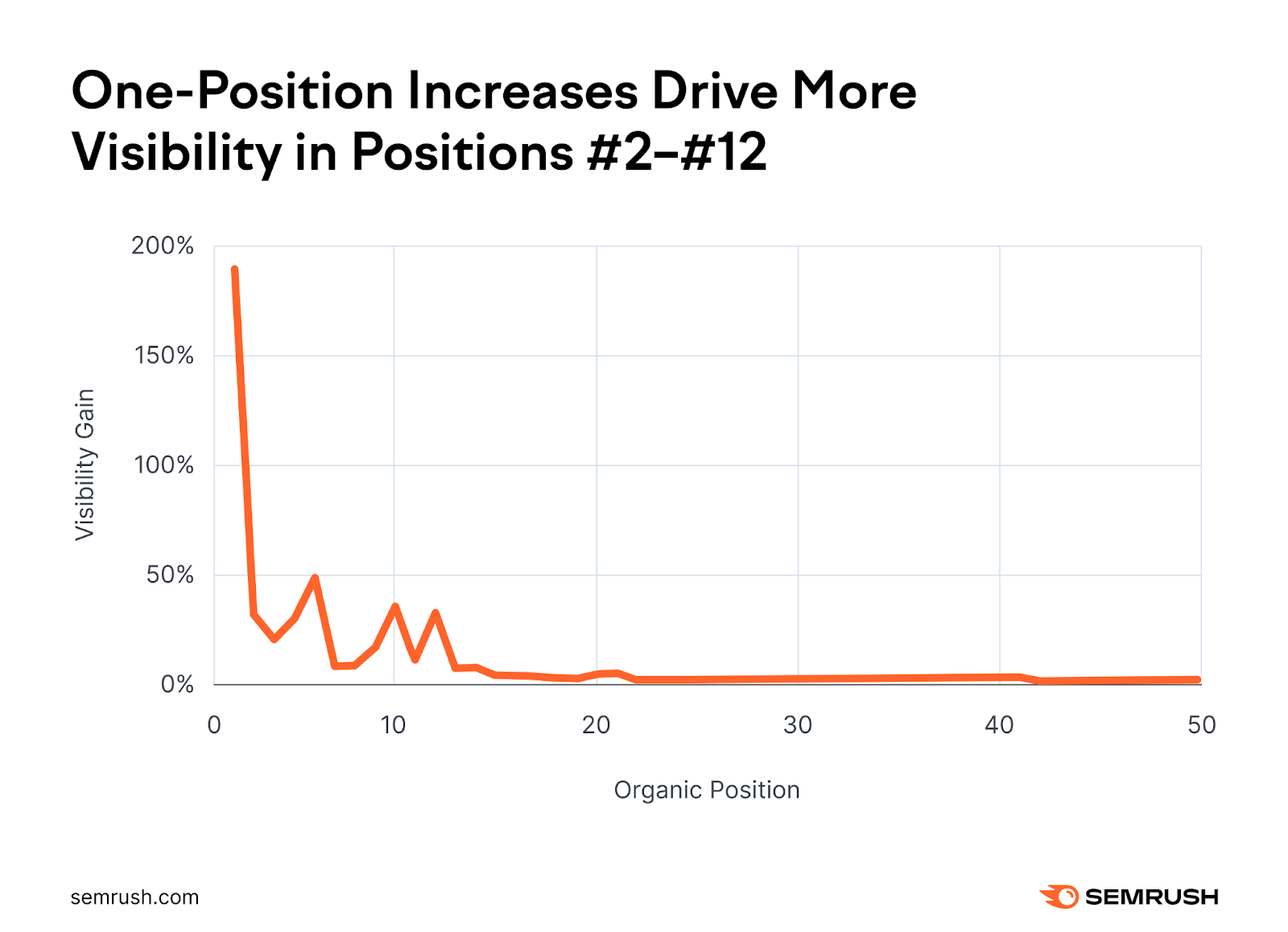
These one-position increases are generally feasible because you’ve already established a good level of authority and relevance. The goal is to beat at least one more competitor.
To maximize webpage visibility improvements, try to identify pages with multiple rankings in the position 2-12 range rather than focusing on individual keywords. You may find opportunities to improve multiple rankings at once.
You can use a tool like Position Tracking to check rankings by page.

To prioritize pages, you may want to consider their commercial importance, potential for improvement, combined keyword search volumes, and other criteria.
Once you’ve selected a page to optimize, here are some ways to boost those high-potential keyword rankings:
- Improve content quality: Make your content as helpful and user-friendly as possible
- Build backlinks to the page: Encourage relevant sites to link to your page
- Build internal links to the page: Link to your page from relevant locations on your site and try to use keyword-rich anchor text
- Improve your on-page SEO: Strategically incorporate target keywords into your content and make sure your content is search engine-friendly
2. Target Low-Difficulty Keywords
Low-difficulty keywords are search terms that are relatively easy to rank highly for because they attract weak competition from other websites. Targeting these terms can be an efficient way to boost your SEO visibility.
Some keyword research tools provide a keyword difficulty score that helps you gauge overall ranking difficulty for discovered keywords.
The Keyword Magic Tool goes a step further by providing a Personal Keyword Difficulty score (PKD %), which represents the difficulty of achieving a top-10 ranking for your website in particular.
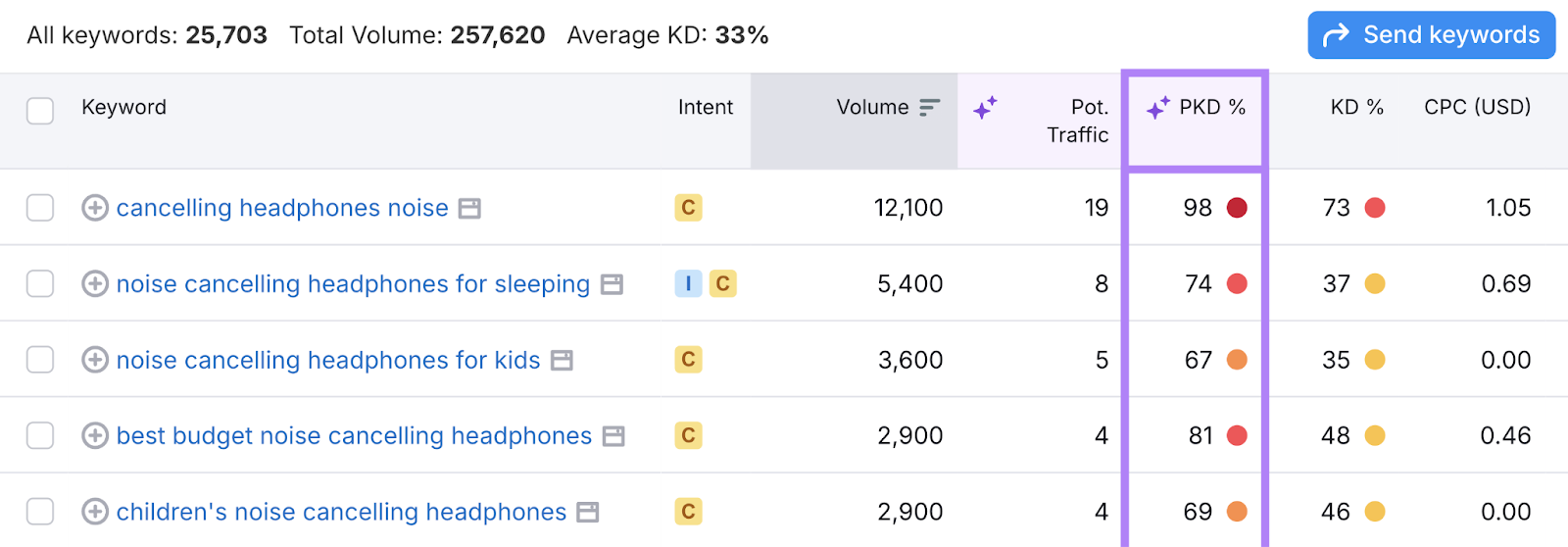
After performing a keyword search, try filtering for results in the 0-29 PKD % (Very Easy to Easy) range.
You can then consider factors like relevance and search volume to identify the best terms for your keyword strategy.
3. Optimize for SERP Features
SERP features are non-standard results that often appear prominently on the search results page. You can boost your visibility by optimizing for certain SERP features.
For example, Google displays AI Overviews on 14.49% of search results pages.* And these overviews typically appear right at the top.
This means that featured sources may be more visible than the organic results below.

You can optimize for AI Overviews by targeting long-tail informational keywords (highly specific phrases people use to find information), using headings to structure your content effectively, and writing in clear language.
Here are some other SERP features you might want to optimize for:
| SERP Feature | Occurrence Rate* | Description | Optimization Tip |
| 34.53% | A box featuring related questions along with answers from the web | Include commonly searched questions in your content and provide clear, useful answers | |
| 1.24% | A webpage extract, typically intended to provide an instant answer and displayed at the top of the results page | Apply the bottom line up front (BLUF) principle, which means providing immediate information and answers before going into extra detail | |
| Image pack | 65.53% | A carousel of image results | Include original, high-quality images in your content and provide descriptive alt text |
| 23.56% | A panel featuring key information about an entity (e.g., a business), which typically appears prominently on the results page | Use schema markup to help Google identify key information about your business | |
| Local pack | 17.42% | Map-based results, typically featuring three business profiles | If you have a local business, create and optimize your Google Business Profile |
| Popular products | 13.25% | Product listings that typically include images, product names, prices, and star ratings | Upload your product feed to the Google Merchant Center and enable free product listings |
| Top stories | 4.96% | A block featuring recent news articles related to the user’s search | Comply with Google News policies and implement schema markup on your news articles |
| Recipes | 1.71% | Recipe listings that typically include images, star ratings, ingredient lists, and cooking times | Use relevant schema markup on your recipes |
In the Position Tracking tool, you can see which SERP features you’re missing out on most. And check the search results pages for the corresponding keywords to see the SERP features yourself.

This allows you to focus your optimization efforts more strategically.
*Occurrence in top 20 Google results, according to Semrush Sensor data for U.S. desktop searches on August 14, 2025
4. Build Brand Awareness
Building brand awareness can improve Google’s perception of your business and encourage more people to search for branded keywords, which you’re likely to maintain top rankings for.
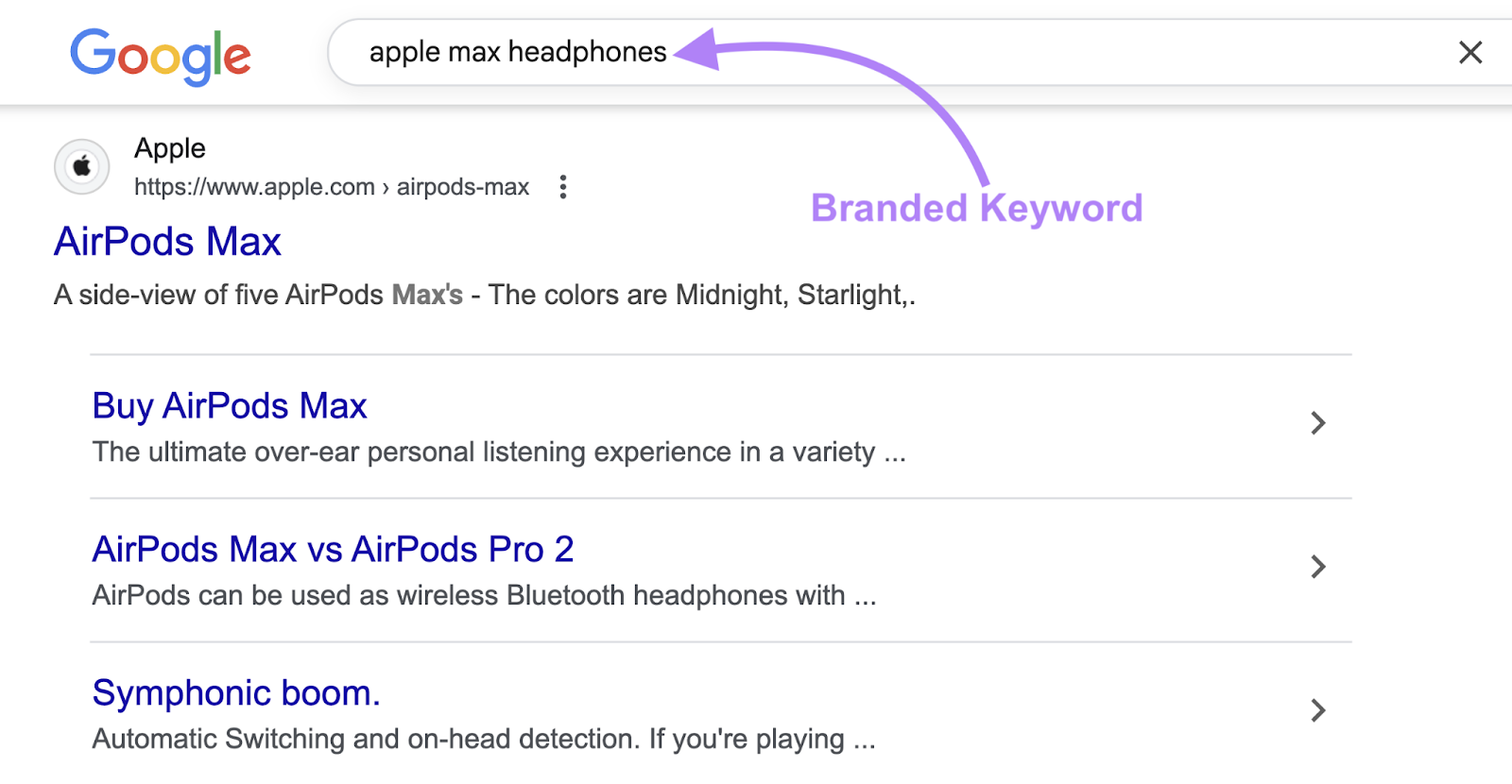
Here are some quick tips for building brand awareness:
- Establish a brand identity that supports your goals
- Use digital PR to generate online exposure for your brand
- Implement an effective social media marketing strategy
- Consider investing in digital advertising, influencer marketing, and traditional advertising
Start Tracking Your SEO Visibility
The easiest way to track your SEO visibility is to use a rank tracking tool with a visibility metric.
To track your SEO visibility through Semrush, set up a Position Tracking campaign with your target keywords.
Then, refer to the “Visibility” graph.

Add up to four competitors’ domains to see how their visibility compares.

You can also tag your keywords to compare SEO visibility scores across different keyword groups.
